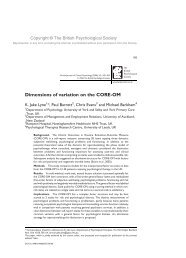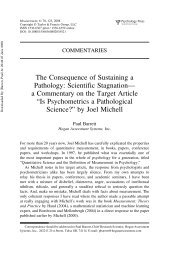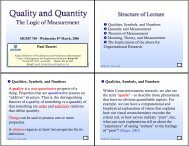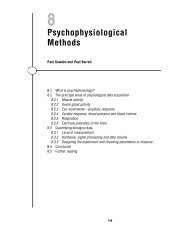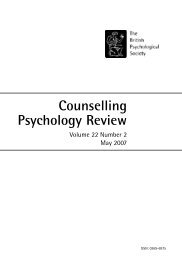103 - Paul Barrett
103 - Paul Barrett
103 - Paul Barrett
You also want an ePaper? Increase the reach of your titles
YUMPU automatically turns print PDFs into web optimized ePapers that Google loves.
B.P. Chapman et al. / Personality and Individual Differences 54 (2013) 479–484 481<br />
Goldberg’s hierarchical factoring procedure begins with one factor—the<br />
overall domain or superfactor—at the highest or first tier.<br />
Factor analysis then extracts two factors, representing two distinct<br />
facets subsumed by the superfactor. Another factor analysis then<br />
extracts three factors, representing three facets, on the third tier.<br />
The process is repeated until a factor emerges on which no items<br />
have their highest loading. Hierarchical factor structures have traditionally<br />
been defined by variance–covariance hierarchies, which<br />
imply correlated factors at each level. Goldberg’s method originally<br />
produced orthogonal variance partitions at each level of the hierarchy<br />
in order to maximize simple structure and defining completely<br />
unique elements of a multi-dimensional scale. However, oblique<br />
rotation may also provide a useful picture of correlations horizontally<br />
or ‘‘within’’, in addition to vertically or ‘‘across’’ the factorial<br />
hierarchy, so we implemented promax rotations. The result is a<br />
tree-like diagram or map, similar to a cluster analysis dendogram,<br />
depicting a broad trait’s increasing differentiation from a molar<br />
composite dimension to molecular facets. A major conceptual distinction<br />
between Goldberg’s method is that it takes a ‘‘top-down’’<br />
approach to hierarchical structure, successively factoring a composite<br />
into more and more components until a level is reached at<br />
which components are essentially indivisible (save for reduction<br />
to discrete items). Conventional ‘‘bottom up’’ approaches work in<br />
the opposite direction, beginning at the item level. A parallel is<br />
seen in hierarchical clustering methods, in which a multi-tiered<br />
structure can be divined by divisive (top-down) or agglomerative<br />
(bottom-up) clustering algorithms.<br />
We also examined the replicability of factors at each level using<br />
repeated split sample replication. This involved first drawing a bootstrap<br />
sample, randomly splitting it, and Procrustes-rotating the factor<br />
solution from one half to the other (using Stata’s implementation<br />
of the algorithm to minimize Frobenius matrix norm) and examining<br />
factor stability, over 1000 bootstrap replicates. Congruence coefficients<br />
are often used to assess factor similarity, are mathematically<br />
equivalent to a Pearson correlation computed using unstandardized<br />
variables, and are thought to index both monotonicity and magnitude-similarity.<br />
However, the fact is the congruence coefficient is<br />
as sensitive to monotonicity relations and insensitive to loading<br />
magnitude as the Pearson correlation. For example, a factor with<br />
loadings of .8, .7 and .6 for three items would possess a congruence<br />
coefficient of 0.96 with a factor on which those same items load .3, .2<br />
and .1; but the Gower index would be 0.5). Thus, instead of congruence<br />
coefficients, we focused on the Gower (1971) similarity coefficient.<br />
Relative to the maximum possible absolute discrepancy<br />
between two factors, the Gower coefficient indicates the average<br />
percent similarity between factors.<br />
Finally, we computed reliability for the scales formed by each<br />
factor’s defining items (loadings >.4). Since item loadings on factors<br />
are typically not all equal, the resulting scales are not essentially<br />
tau-equivalent and thus Cronbach’s alpha will not accurately estimate<br />
internal consistency reliability (Raykov, 1997), in addition to<br />
imposing a harsh penalty for short scales. We therefore provide<br />
Bentler’s (2009) model-based composite reliability index, which<br />
allows variation in factor loadings and does not explicitly penalize<br />
scale length.<br />
3. Results<br />
Figure 1 shows the tree diagram for the Neuroticism domain.<br />
After extraction of the fourth factor, no items had their highest<br />
loading on subsequent factors. The four factors at the bottom tier<br />
(with representative items) were: Oversensitivity (‘‘Are your feelings<br />
rather easily hurt’’, ‘‘Are you easily hurt when people find<br />
fault with your work’’), Mood Lability (‘‘Does your mood go up<br />
and down’’, ‘‘Are you sometimes bubbling over with energy and<br />
sometimes very sluggish’’), Nervous Tension (‘‘Would you call<br />
yourself tense or high strung’’, ‘‘Would you call yourself a nervous<br />
person’’), and Rumination (‘‘Do ideas run through your head so<br />
that you cannot sleep’’, ‘‘Do you suffer from sleeplessness’’).<br />
Figure 2 shows the tree diagram for EPI Extraversion; extraction<br />
stopped after six factors, as the seventh factor contained no items<br />
with their highest loadings. The six factors were Social Dynamism<br />
(‘‘Can you usually let yourself go and enjoy yourself a lot at a lively<br />
party’’, ‘‘Can you easily get some life into a rather dull party’’),<br />
Communalism (‘‘Generally, do you prefer meeting people to reading’’,<br />
‘‘If there is something you want to know, would you rather<br />
talk to someone about it than look it up in a book’’), Sociotropy<br />
(‘‘Do you like talking to people so much that you never miss a<br />
chance of talking to a stranger’’, ‘‘Would you be very unhappy if<br />
you could not see lots of people most of the time’’), Haste (‘‘Do<br />
you like doing things in which you have to act quickly’’, ‘‘Would<br />
you say that you were fairly self-confident’’), Mischievousness<br />
(‘‘Do you like playing pranks on others’’, ‘‘Do you love being with<br />
a crowd who plays jokes on one another’’), and Impulsivity (‘‘Do<br />
you generally do and say things quickly, without stopping to<br />
think’’, ‘‘Do you stop and think something over before doing it).<br />
The ‘‘Lie’’ scale could be broken into two factors: Interpersonal<br />
Virtue (‘‘Do you never lose your temper and get angry’’, ‘‘Do you<br />
never gossip’’), and Behavioral Diligence (‘‘If you say you will do<br />
something, do you always keep your promise, no matter how<br />
inconvenient it might be to do so’’, ‘‘Would you always declare<br />
everything at customs, even if you knew that you could never be<br />
found out’’). The pattern matrices for the lowest tier solution from<br />
each hierarchy are depicted in Supplemental Tables 1–3.<br />
Table 1 displays mean Gower similarity coefficients for factors<br />
at each tier of each domain over 1000 split sample replications.<br />
Ninety-five percentage of confidence limitless for these coefficients<br />
were almost uniformly within .01 in each direction. Most factors<br />
showed relatively strong average percent agreements (>.7),<br />
although ‘‘Lie’’ scale subfactors showed a bit less stability. In general,<br />
greater replicability occurred for more specific factors at lower<br />
tiers of the hierarchies. Table 1 also shows model-based<br />
composite internal consistency reliability for the scales formed<br />
by the items loading over .4 on each factor (denoted in Fig. 1–3).<br />
In general, composite reliabilities were adequate to good (.7–.8)<br />
even for small factors at lower tiers.<br />
4. Discussion<br />
4.1. Theoretical and historical implications<br />
The facet structures we identified reflect a measurement operationalization<br />
of Neuroticism and Extraversion based on Eysenck’s<br />
theory at the time (Eysenck, 1947, 1952). In contrast to the specific<br />
emotions (depression, anxiety, anger) of multi-faceted Five-Factor<br />
Model Neuroticism scales (Costa & McCrae, 1992), the EPI Neuroticism<br />
scale focuses specifically on anxiety. This emerged in the<br />
Rumination, as well as Nervous Tension facets. The latter reflects<br />
Eysenck’s conceptualization of the biological underpinnings of<br />
Neuroticism, sympathetic nervous system reactivity (‘‘Do you get<br />
palpitations or thumping in your heart’’). One facet of Big Five<br />
Neuroticism—vulnerability—reflects fluctuating mood and the potential<br />
to fall apart under criticism, and is emphasized on the EPI<br />
in both the Oversensitivity and the Mood Lability facets.<br />
Eysenck’s theorized biological basis of Extraversion—the<br />
Ascending Reticular Activating System—is apparent in Extraversion<br />
facets reflecting social stimulation seeking and aversion to solitary,<br />
low-arousal activities like reading. Again, this conceptualization of<br />
Extraversion differs slightly from modern Big Five versions, which<br />
tend to spread the assessment of impulsiveness and similar constructs<br />
(i.e. constraint, sensation seeking) across Extraversion, Neuroticism,<br />
and Conscientiousness (Costa & McCrae, 1992).



